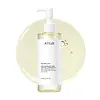What's inside
What's inside
 Key Ingredients
Key Ingredients

 Benefits
Benefits

 Concerns
Concerns

 Ingredients Side-by-side
Ingredients Side-by-side

Water
Skin ConditioningHelianthus Annuus Seed Oil
EmollientGlycerin
HumectantCetearyl Alcohol
Emollient1,2-Hexanediol
Skin ConditioningGlyceryl Stearate
EmollientPanthenol
Skin ConditioningDecyl Glucoside
CleansingArachidyl Alcohol
EmollientButylene Glycol
HumectantDiheptyl Succinate
EmollientBehenyl Alcohol
EmollientArachidyl Glucoside
EmulsifyingHydroxyethyl Acrylate/Sodium Acryloyldimethyl Taurate Copolymer
Emulsion StabilisingAllantoin
Skin ConditioningCitric Acid
BufferingTocopherol
AntioxidantCapryloyl Glycerin/Sebacic Acid Copolymer
Skin ConditioningSimmondsia Chinensis Seed Oil
EmollientPropanediol
SolventGlucose
HumectantCentella Asiatica Extract
CleansingHydrogenated Lecithin
EmulsifyingAvena Sativa Protein Extract
Skin ConditioningStearic Acid
CleansingAloe Barbadensis Leaf Extract
EmollientSilica
AbrasiveCeramide NP
Skin ConditioningSodium Hyaluronate
HumectantBioflavonoids
Skin ConditioningHydrolyzed Wheat Protein
Skin ConditioningHydrolyzed Sweet Almond Protein
Skin ConditioningGlycine Soja Protein
EmulsifyingCeramide Ns
Skin ConditioningPropolis Extract
Skin ConditioningPhytosphingosine
Skin ConditioningCholesterol
EmollientMilk Protein
Skin ConditioningBrassica Oleracea Italica Extract
AstringentAsiaticoside
AntioxidantCeramide AP
Skin ConditioningCeramide As
Skin ConditioningAsiatic Acid
Skin ConditioningMadecassic Acid
Skin ConditioningMadecassoside
AntioxidantCeramide EOP
Skin ConditioningWater, Helianthus Annuus Seed Oil, Glycerin, Cetearyl Alcohol, 1,2-Hexanediol, Glyceryl Stearate, Panthenol, Decyl Glucoside, Arachidyl Alcohol, Butylene Glycol, Diheptyl Succinate, Behenyl Alcohol, Arachidyl Glucoside, Hydroxyethyl Acrylate/Sodium Acryloyldimethyl Taurate Copolymer, Allantoin, Citric Acid, Tocopherol, Capryloyl Glycerin/Sebacic Acid Copolymer, Simmondsia Chinensis Seed Oil, Propanediol, Glucose, Centella Asiatica Extract, Hydrogenated Lecithin, Avena Sativa Protein Extract, Stearic Acid, Aloe Barbadensis Leaf Extract, Silica, Ceramide NP, Sodium Hyaluronate, Bioflavonoids, Hydrolyzed Wheat Protein, Hydrolyzed Sweet Almond Protein, Glycine Soja Protein, Ceramide Ns, Propolis Extract, Phytosphingosine, Cholesterol, Milk Protein, Brassica Oleracea Italica Extract, Asiaticoside, Ceramide AP, Ceramide As, Asiatic Acid, Madecassic Acid, Madecassoside, Ceramide EOP
Ethylhexyl Palmitate
EmollientSorbeth-30 Tetraoleate
EmulsifyingSorbitan Sesquioleate
EmulsifyingCaprylic/Capric Triglyceride
MaskingButyl Avocadate
Skin ConditioningParfum
MaskingHelianthus Annuus Seed Oil
EmollientMacadamia Ternifolia Seed Oil
EmollientOlea Europaea Fruit Oil
MaskingSimmondsia Chinensis Seed Oil
EmollientVitis Vinifera Seed Oil
EmollientCaprylyl Glycol
EmollientEthylhexylglycerin
Skin ConditioningCurcuma Longa Root Extract
MaskingMelia Azadirachta Flower Extract
Skin ConditioningTocopherol
AntioxidantMelia Azadirachta Leaf Extract
Skin ConditioningHouttuynia Cordata Extract
Skin ConditioningCorallina Officinalis Extract
Skin ConditioningMelia Azadirachta Bark Extract
AntimicrobialMoringa Oleifera Seed Oil
EmollientOcimum Sanctum Leaf Extract
Skin ConditioningEthylhexyl Palmitate, Sorbeth-30 Tetraoleate, Sorbitan Sesquioleate, Caprylic/Capric Triglyceride, Butyl Avocadate, Parfum, Helianthus Annuus Seed Oil, Macadamia Ternifolia Seed Oil, Olea Europaea Fruit Oil, Simmondsia Chinensis Seed Oil, Vitis Vinifera Seed Oil, Caprylyl Glycol, Ethylhexylglycerin, Curcuma Longa Root Extract, Melia Azadirachta Flower Extract, Tocopherol, Melia Azadirachta Leaf Extract, Houttuynia Cordata Extract, Corallina Officinalis Extract, Melia Azadirachta Bark Extract, Moringa Oleifera Seed Oil, Ocimum Sanctum Leaf Extract
 Reviews
Reviews

Ingredients Explained
These ingredients are found in both products.
Ingredients higher up in an ingredient list are typically present in a larger amount.
Helianthus Annuus Seed Oil is the oil derived from the seeds of a Sunflower. Sunflower seed oil is non-fragrant. It is an emollient, meaning it helps to soften the skin.
Sunflower seed oil contains many fatty acids. The fatty acids found in sunflower seeds include (from highest amount to least): linoleic acid, myristic acid, palmitic acid, stearic acid, arachidic acid, oleic acid, and linolenic acid.
These fatty acids help the skin create ceramides. Ceramides play a role in repairing the skin barrier.
Helianthus Annuus Seed Oil helps moisturize the skin. This in turn helps the skin look more rejuvenated and smoother.
Sunflowers are rich in vitamin E.
Historians believe Indigenous cultures of North America domesticated sunflowers before corn. Thus they relied on sunflower oil for a variety of uses. One such use is moisturizing skin and hair.
Sunflower seed oil may not be fungal acne safe. We recommend speaking with a professional if you have any concerns.
Learn more about Helianthus Annuus Seed OilThis oil comes from the seeds of the desert shrub called Jojoba. It is more commonly known as jojoba oil, a non-comedogenic oil.
Jojoba oil does not contain fragrance and has many fatty-acids, making it a great soothing ingredient.
It also contains Vitamin E, a great moisturizing ingredient. Vitamin E is also an antioxidant and protects your skin against oxidative damage.
This ingredient humectant properties, meaning it helps draw moisture from the air. This helps keep your skin hydrated.
While jojoba has antibacterial properties, it is only able to kill some strains of bacteria.
Studies also show it helps in wound healing. In fact, Indigenous cultures have used jojoba as a moisturizer and to help treat burns for centuries.
Fun fact: Jojoba oil similar to natural human skin sebum, so it has a great effect on dry skin. It is also promising with helping to regulate sebum production.
Due to its fatty acid content, Jojoba oil may not be fungal acne safe. We recommend speaking with a professional if you have any concerns.
Learn more about Simmondsia Chinensis Seed OilTocopherol (also known as Vitamin E) is a common antioxidant used to help protect the skin from free-radicals and strengthen the skin barrier. It's also fat soluble - this means our skin is great at absorbing it.
Vitamin E also helps keep your natural skin lipids healthy. Your lipid skin barrier naturally consists of lipids, ceramides, and fatty acids. Vitamin E offers extra protection for your skin’s lipid barrier, keeping your skin healthy and nourished.
Another benefit is a bit of UV protection. Vitamin E helps reduce the damage caused by UVB rays. (It should not replace your sunscreen). Combining it with Vitamin C can decrease sunburned cells and hyperpigmentation after UV exposure.
You might have noticed Vitamin E + C often paired together. This is because it is great at stabilizing Vitamin C. Using the two together helps increase the effectiveness of both ingredients.
There are often claims that Vitamin E can reduce/prevent scarring, but these claims haven't been confirmed by scientific research.
Learn more about Tocopherol